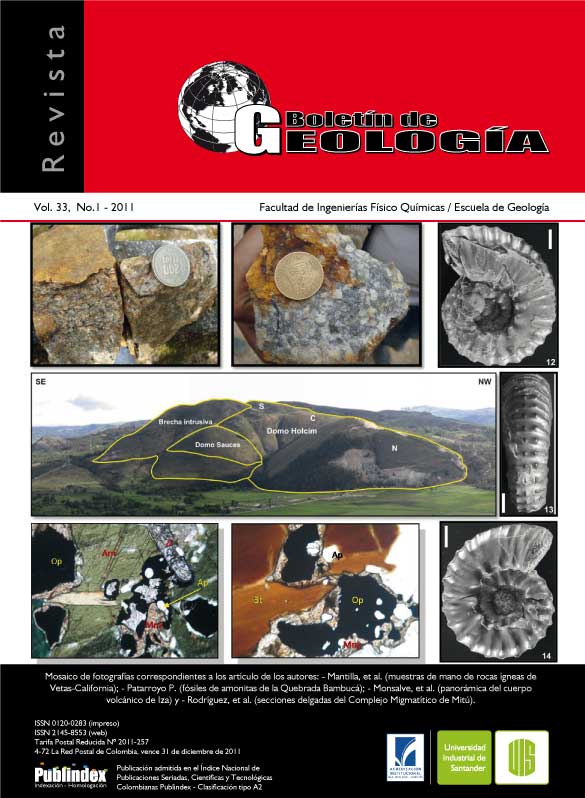STRUCTURAL MODELING OF THE VICHADA IMPACT STRUCTURE FROM INTERPRETED GROUND GRAVITY AND MAGNETIC ANOMALIES
Published 2012-02-20
How to Cite
Abstract
A prominent positive free-air gravity anomaly mapped over a roughly 50-km diameter basin is consistent with a mascon centered on (4o30`N, -69o15`W) in the Vichada Department, Colombia, South America. Ground follow up gravity and magnetic anomalies were modeled confirming the regional free air gravity anomalies. These potential field anomalies infer a hidden complex impact basin structure filled with tertiary sedimentary rocks and recent quaternary deposits. Negative Bougueranomalies of 8 mGals to 15 mGals amplitude are associated with a concentric sedimentary basin with a varying thickness from 100m to 500 m in the outer rings to 700m to 1000m at the center of the impact crater basin. Strong positive magnetic anomalies of 100 nT to 300 nT amplitude infer the presence of a local Precambrian crystalline basement that was affected by intensive faulting producing tectonic blocks dipping to the center of the structure, showing a typical “domino structure” of impact craters such as that of Sudbury, Ontario, Canada. Basic to intermediate mineralized veins and dikes with contrasting density and magnetic susceptibility properties could be emplaced along these faulting zones, as inferred from local gravity and magnetic highs. The geologic mapping of the area is limited by the flat topography and absence of outcrops/ geomorphologic units. Nevertheless, local normal faults along the inner ring together with radially sparse irregular blocks over flat terrains can be associated with terraced rimsor collapse of the inner crater structure and ejecta blanket, respectively. A detailed airborne electromagnetic survey is recommended to confirm the gravity and magnetic anomalies together with a seismic program to evaluate the economic implications for energy and mineral exploration of the Vichada impact structure.
Keywords: Vichada impact structure, Gravity, Magnetic, ejecta, terraced rims.
Downloads
References
Buczkowski, D. L., Frey, H. V., McGill, G. E. and Roark, J. H. 2005. Buried impact craters; a topographic analysis of quasi-circular depressions, Utopia basin, Mars, J. Geophys.Res., 110, E03007, doi:10.1029/2004JE002324
Carporzen, L., Glider S. A. and Hart, R. J. 2005. Paleomagnetism of the Vredefort meteorite crater and implications for craters on Mars, Nature, 435: 198–201
De la Espriella, R., Flórez, R., Galvis, J., González, C.F., Mariño, J. y Pinto, H. 1990. Geología Regional del Norte de la Comisaría del Vichada. Geología Colombiana, 17: 93-106.
Grieve, R.A.F. and Masaitis, V.L. 1994. The economic potential of terrestrial impact craters: Internat. Geol. Rev., 36: 105-151
Hernandez, O. 2006 Tectonic analysis of northwestern South America from integrated Satellite, airborne and surface potential field anomalies, PhD dissertation, School of Earth Sciences, The Ohio State University, 198p.
Hernández, O., von Frese, R. and Khurama, S. 2007. Geophysical Evidence of an Impact Crater in Northwestern South America, Joint assembly AGU, Acapulco, may 2007
Hernández, O., von Frese R. and Khurama S. 2009. Geophysical evidence for an impact crater in Vichada, Northwestern South America and its economic potential, Earth Sci. Res. J., 13 (2): 7-17
Hernández, O., von Frese R.R.B. and Alexander G.C. 2010. Structural modeling of the Vichada impact structure from interpreted ground gravity and magnetic anomalies. 2010 meeting of the Americas, Foz do Iguassu, Brazil 91 (26), meet. am. suppl
Ivanov, B. A. and Melosh, H. J. 2003. Large scale impacts and triggered volcanism. Nördlingen, Germany, (http://www.lpi.usra.edu/ meetings/largeimpacts2003/pdf/4062.pdf).
Keary, P. and Brooks, M. 1984. An Introduction to Geophysical Exploration, Second Edition. Blackwell Scientific Publications, 254 p.
Khurama, S. 2007 Caracterización geológica y geofísica de la estructura del Rio Vichada, Inspección de Palmarito, Departamento de Vichada, MSc thesis, Geosciences Department, Universidad Nacional de Colombia, 164p.
Lemoine, F.G., Chinn, D.S., Cox, S.M., Factor, J.K. Kenyon, S.C. , Klosko, S.M., Luthcke, S.B., Olson, T.R., Pavlis, E.C., Pavlis, N.K., Rapp, R.H., Smith, W.H.F. and Sandwell, D.T. 1998. The development of the Joint NASA GSFC and National Imagery and Mapping Agency (NIMA) Geopotential Model EGM96, NASA/TP-1998 – 206861, NASA Goddard Space Flight Cent., Greenbelt, Md.
